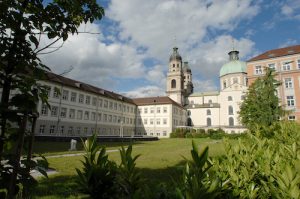Over the last two years, our Innsbruck School of Catholic Theology has worked out new curricula for our study programs in Catholic Theology, Catholic religious education, and Philosophy. The diploma program in Catholic Theology – somehow the flagship – is a 5-year- (10-semester-) program. Following the framework conditions by Austrian law, Innsbruck University’s bylaws, and the Austrian bishops‘ conference’s guidelines, 4 courses with 2 weekly hours each were assigned to the subject of liturgy. This is a little less than we used to have in recent years. But the number of elective courses was significantly increased over the entire program, hence every professor had to pay a certain price in the field of compulsory courses.
The curricula have not yet been brought into effect – some minor changes might take place before we start, as hoped, in October 2021 – but I want to let Pray Tell readers know what decisions we made in the area of liturgical studies, covered by prof. Reinhard Messner and me as his assistant professor.
We start with a 2-hour-course, “Introduction to Liturgy.” This course contains more or less what I explained in this post. What I showed you there was a 1-hour-course. In the new 2-hour-shape I will not change the topics themselves but go deeper into the material, leave more time for queries and discussion, and introduce more compulsory reading for the final exam. The students should take this course in the 2nd of 10 semesters. There was no such introductory course in the old curriculum, but our experience has shown that it will be useful as a first step of orientation.
Next comes the 2-hour-course “Baptism and Eucharist” by prof. Messner. Different from others in the German area who lecture courses exclusively on Eucharist, Reinhard Messner has always emphasized the theological connection between baptism, confirmation, and Eucharist. While the aforementioned introductory course is supposed to give a simplified overview over liturgical patterns, history of liturgy, terminology, and some current discussions, the lecture “Baptism and Eucharist” goes deep into detailed interpretation of certain Biblical sources, primary texts of the past and the present, and issues of current liturgical practice. This lecture is supposed to be taken in the 3rd semester.
“Liturgy in the rhythm of time” follows in the 7th semester. This was a tough decision, but eventually we stuck to the long established practice of rotational topics: The students learn about either a) the Liturgy of the Hours, or b) Easter and the liturgical year, or c) sacraments and sacramentals. This is a bit arbitrary, and others might prefer a combined overview over all those areas. In Innsbruck, liturgical studies have always been a source-oriented field where the deep and precise interpretation of texts and patterns carries more weight than “schoolbook knowledge” (for which we have the introductory course).
The fourth and final course in the 8th semester is “Specific questions in Liturgical Studies” where prof. Messner presents and discusses exemplary issues from the academic world. While all other courses are lectures with final exams, this is a workshop with different sorts of papers, talks, and regular tasks for all students.
For the new study program we had to abolish two 1-hour-lectures from the old curriculum: “Office and ordination” and “reading course on ‘mysterion’ and ‘sacramentum’” are now both included in the three-year-cycle of the “rhythm-of-time” lecture.
Liturgical studies are also included in the introductory course “Biblical and Historical studies” in the 2nd semester. Additionally we will offer different elective courses. Reinhard Messner regularly teaches Syriac language in a 2-semester-program, a course which is mainly chosen by students of other fields than theology. I teach Gregorian chant every few semesters, a course chosen by theologians, historians, musicologists, and others. We can conduct seminars on our own as well as joint seminars with Biblical scholars, historians, philosophers etc. But all those courses are not compulsory for the students.
The extent of liturgical studies in the diploma program is similar to most other Catholic schools in German speaking countries. Nevertheless Innsbruck – where Josef Andreas Jungmann S. J. became probably the most influential liturgical scholar of the 20th century although he never held a chair of liturgical studies – will continue to be more focused on historical and exegetical approaches to liturgy, while others prefer more dogmatic or practical approaches.


Leave a Reply